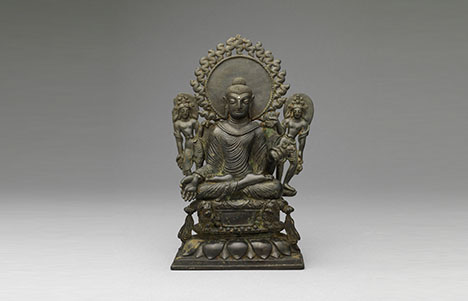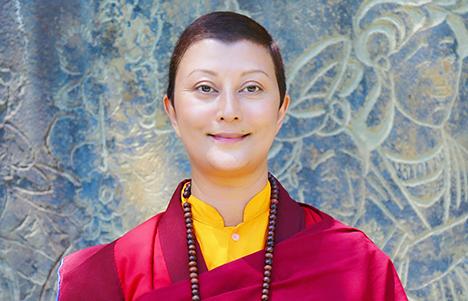
About the Meditation
Meditation session led by Lama Aria Drolma.
The guided meditation begins at 13:00.
For centuries Himalayan practitioners have used meditation to quiet the mind, open the heart, calm the nervous system, and increase focus. Now Western scientists, business leaders, and the secular world have embraced meditation as a vital tool for brain health.
Whether you’re a beginner, a dabbler, or a skilled meditator seeking the company of others, join expert teachers in a forty-five-minute weekly program designed to fit into your lunch break. Each session will be inspired by a different work of art from the Rubin Museum’s collection and will include an opening talk, a twenty-minute meditation session, and a closing discussion.
Presented in partnership with Sharon Salzberg and the Interdependence Project. This program is supported in part by the Hemera Foundation.


RELATED ARTWORK
Theme:Resilience

This sculpture bears many characteristics of bronze images from the Swat Valley, including the use of a dark metal alloy, thick wave-shaped flames surrounding the head and nimbus, the folds of the Buddha’s robes, and the type of throne. The throne has a large central textile with thick tassels along the edge and two ribbons hanging from the sides, and it sits on a lotus with fleshy downturned petals. The Buddha’s robe covers his shoulders, forming a thick wide collar and an undulating hem at the legs. The figures flanking the throne back are stylistically consistent but extremely flat.
In a manner typical for Swat imagery, Buddha Shakyamuni performs the gesture of giving (varadamudra) and holds the end of his robe. He sits cross-legged on a lion throne, a traditional symbol for a universal ruler (chakravartin). He is flanked by two smaller bodhisattvas: Avalokiteshvara holding a lotus flower to his right and Maitreya holding a flask to his left. Most of these features can be traced to earlier art of the Gandharan region, but Maitreya’s veneration gesture, with his palm raised, is typical for the period.
About the Speaker

Lama Aria Drolma is a formally authorized Buddhist teacher trained in the Karma Kagyu tradition of Tibetan Buddhism. She has over a decade of monastic study and meditation training and is a graduate of the three-year, three-month traditional Tibetan Buddhist retreat, an advanced cloistered meditation training program at Palpung Thubten Choling Monastery, New York.
She is respected as a leading expert in Mindfulness Meditation and has trained extensively in the Dharma Path Program of Mindfulness and Contemplations at Palpung Thubten Choling Monastery, New York.
Lama Aria Drolma teaches worldwide, leading retreats, workshops, and corporate meditation programs, and she is a popular guest speaker at universities and organizations. She teaches Vajrayana Buddhism and Buddhist principles, making them relevant to our everyday lives, helping us cultivate loving-kindness and compassion, and bringing about a transformation of contentment and well-being.
